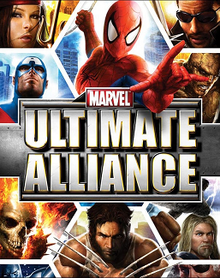| Marvel Ultimate Alliance | |
|---|---|
 | |
| Developer(s) | Raven Software[a] |
| Publisher(s) | Activision |
| Director(s) | Dan Vondrak |
| Producer(s) | Matthew Paul |
| Designer(s) | Keith Fuller |
| Programmer(s) |
|
| Artist(s) | Dan Hay |
| Writer(s) | Robert Love |
| Composer(s) | |
| Series | Marvel: Ultimate Alliance |
| Engine | Vicarious Visions Alchemy |
| Platform(s) | |
| Release | October 24, 2006 |
| Genre(s) | Action role-playing |
| Mode(s) | Single-player, multiplayer |
Marvel: Ultimate Alliance is a 2006 action role-playing video game published by Activision for various gaming systems. Developed by Raven Software, Ultimate Alliance is set within the fictional Marvel Universe and features many of the superheroes, supervillains, and supporting characters that appear in publications by Marvel Comics. It shares many similarities with Raven Software's previous Marvel titles, X-Men Legends and X-Men Legends II: Rise of Apocalypse, in that it allows players to select from its vast cast to create the ultimate superhero team. The game features an original plot in which the heroes of the Marvel Universe must join forces to defeat Doctor Doom and his Masters of Evil and foil their plans for global domination.
Raven Software developed and released it on PlayStation 2, Xbox and Xbox 360 on October 24, 2006, while additionally versions for PlayStation Portable (ported by Vicarious Visions) and Microsoft Windows (ported by Beenox) were also released on the same day, as well as a distinctly different Game Boy Advance version, developed by Barking Lizards Technologies. Shortly thereafter, Ultimate Alliance was released as a launch title for both the PlayStation 3 and Wii consoles in November 2006, the latter ported by Vicarious Visions; the PlayStation 3 version was one of three launch games for the system (along with NBA 07 and Ridge Racer 7) to run at 1080p resolution.
Upon release, the game was met with largely positive reviews from critics, who praised its simple but entertaining gameplay, and its impressive selection of Marvel characters. A sequel, Marvel: Ultimate Alliance 2, was developed for multiple platforms by Vicarious Visions, n-Space and Savage Entertainment and released in 2009. A third game, Marvel Ultimate Alliance 3: The Black Order, was developed by Koei Tecmo's Team Ninja and published by Nintendo for the Nintendo Switch in 2019. Marvel: Ultimate Alliance was re-released in 2016, ported by Zoë Mode, on Windows, PlayStation 4, and Xbox One.
- ^ "SDCC 2016: MARVEL ULTIMATE ALLIANCE". Marvel. 2016-07-23. Archived from the original on 2016-08-08. Retrieved 2016-07-23.
- ^ "SDCC 2016: MARVEL ULTIMATE ALLIANCE". Marvel. 2016-07-23. Archived from the original on 2016-08-08. Retrieved 2016-07-23.
- ^ "Here's What the Updated Marvel Ultimate Alliance 1 and 2 Look Like". GameSpot. 2016-07-24. Archived from the original on 2016-07-29. Retrieved 2016-07-24.
Cite error: There are <ref group=lower-alpha> tags or {{efn}} templates on this page, but the references will not show without a {{reflist|group=lower-alpha}} template or {{notelist}} template (see the help page).